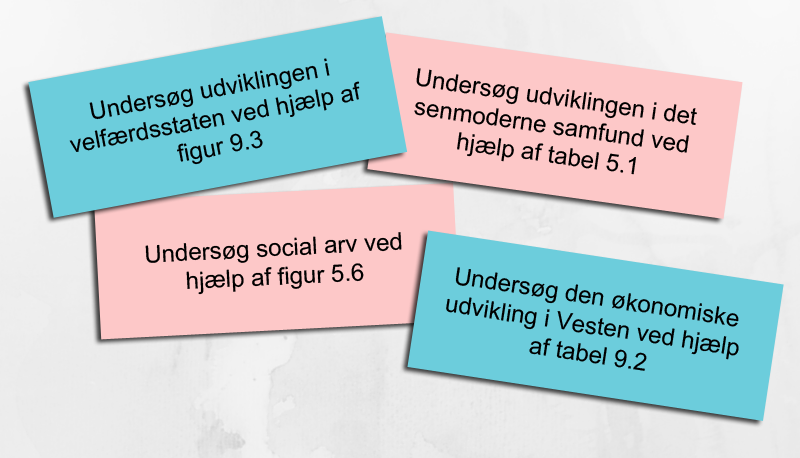Because many student find it hard to understand graphs and tables we need to help them practice reading graphs and tables While we of course practice this throughout the year. When exams roll around, I tend to explicitly train with them. Here are a few ideas for how to do this.
In my classroom the end of the year tend to mean that it is time to start reviewing. One of the skills that the students still had trouble with and wanted to practice was reading graphs and tables – something we had been doing throughout the year. So I decided to use a CL-structure and get them practicing in pairs. So I turned to my trusted paper slips.
Motivation: A very quite class
This year in one of my classes the biggest challenge has been to get the students to practice talking the class work out loud – so that they have used the technical term. They also need to train the kind of things they need to do n the oral exam. It was a samfundsfag C class which means that part of their oral exam is always reading a graph or a table and relate that the wider issue that they are tested on.
I know, I know, in most classes the problem is to keep the noise level down – but here the worrying thing was how quiet they were during team work exercises. Left to their own devices what they would do when they were given team or pair work was: Solve it alone, write the answers down and then and only then if there were anymore time they would talk to each other.
Toward the end of the semester I realised how much they did this and went figuring out about ways to solving it. I turned to CL structures to give them structure that would encourage them to talk to each other. I have noticed that if I print questions on colored paper, they are now apparently fun and get them to talk. What this class will worry about though is getting notes for the class if they are forced to solve a talk orally.
The lesson: Practice reading graphs and tables
This lesson utiles CL-structures to practice reading graphs and tables by having the class work in pairs on a number of different graphs working form a question.
Time: 45 minutes
Materials: Pre-printed paper slips & a text book with graphs and tables or printed graphs and tables
The prep
- I looked at all the graphs and tables in our textbook and made a question for each of them. With clear references to which graph in the book they were to look at. I framed the questions so they looked as much as the oral exam questions as I could make them.
- I put one question on each paper slip (I got a template for making them).
- I printed three sets of questions on colored paper – each set was a different color (because apparently colored paper makes things fun – don’t ask me why)
- Cut the each set into slips

In class
- I started by asking my students to divide themselves into two groups – those who felt that graphs and tables was hard and those who didn’t. Only do this if the class culture isn’t competitive. You can also make the pairs beforehand based on their competency with reading graphs.
- Then I made pairs out of each group, so that the students who felt confident was with others who felt confident and those who didn’t was with others who wasn’t feeling as confident either.
- Give every pair a slip with a question on it.
- I then told them to pick a slip and go sit together and answer the question on the slip. Once they were done they were to go up to my table and get a new slip. They were told that they could only pick questions from the color pile as their first slip
- If they had a question they could write their name on the board and I would come help them.
- They worked like this for about half an hour.
The results
- All the students were active
- Everyone was practicing to read and talk about graphs and tables
- The energy level was really high as everyone tried to get to all the slips
- Some of the groups really tried to get a deeper understanding of each graph or table.
- After the allotted time was up, I talked to them about the exercise and they all agreed that it had been great practice and fun.
- Everyone was confident that they could read any graph or table I might give them for the oral exam.
- Nobody had any problems reading a graph or a table for the oral exams.
Free printable
Here is the questions slips I used. They are created for “Luk Samfundet Op”, second edition. Grab it here. They are of course in Danish, but perhaps you can use them as inspiration.
This post was originally posted: May 30, 2015. Updated June 23, 2023


Leave a Reply